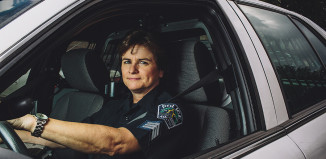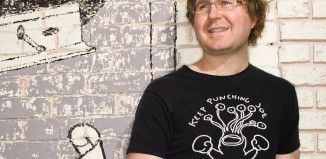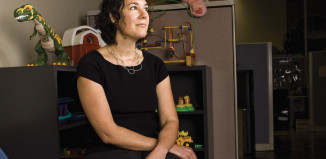Picture it: Middle-aged white man – thin and pasty with a certain nerdy-accountant visage – on stage singing Lionel Richie hits – the “Back to Front” album to be exact – while acting out the plot of a tragic, operatic love story.
Confused? You probably have to see Neal Medlyn in action to appreciate the sheer genius that’s won him acclaim from the likes of the New York Times and Variety (he’s been called the Paris Hilton of performance art-and yeah we’re not sure how to take that one either). Medlyn performed his Lionel Richie Opera in Austin at Fusebox 2008 and will return to do a similar treatment with the Beyonce Experience Live album when the Austin festival hits local stages again in April.
It was performances like Medlyn’s – raw, funny, quirky and totally freakin’ entertaining – that left Brent Hasty rapt at Fuse Box last spring. The University of Texas professor and art aficionado, along with partner Stephen Mills and several friends, had decided to attend a series of shows, all part of the innovative festival that explores the boundaries of performance disciplines.
But Hasty was surprised when the shows elicited quite powerful reactions from he and the rest of the audiences, running the gamut from complete joy to even anger in one case.
“It engaged me completely,” he says, “We had fantastic conversations about the pieces afterwards. And I thought to myself: that’s what an art festival should do.”
Now in its fifth year, Fuse Box got its start when Austin artist Ron Berry sought a platform for artists to engage and learn from other creators. Think of Fuse Box as doing for performance artists what South By Southwest does for musicians and filmmakers.
What began as a weekend has grown to 10 days of performances centered around new works that dance the lines between performance mediums like theatre, music, film and visual arts. Roughly 25 percent of the artists are from Texas, with the vast majority coming from elsewhere around the world. All of the work is fresh, some of it even commissioned by Berry for Fuse Box.
Last year, the festival drew 12,000 attendees, more than double the figure from 2007. “Ron’s vision is to find artists who are doing interesting work and experimenting,” says Hasty. “The question is what happens when they cross the threshold limits of different disciplines and what does that mean? And what we see is that this tends to be where some of the best work is happening.”
Hasty himself is no stranger to the arts world. He earned a theatre performance degree from Northwestern University, taught in a performing arts high school and has worked in nonprofits and arts education for most of his career. In addition, his partner Mills is the accomplished creative director for Ballet Austin, which further ingrains the couple in the performance arts scene.
But Hasty says while he’s attended festivals akin to Fuse Box in Europe, nothing really come close to it in this part of the world – until Berry came along.
“When people are challenging themselves, taking risks, it clarifies for you what about the discipline you really love and is sacred to you,” he says, explaining his personal interest in the festival.
After last year’s Fuse Box, Hasty asked Berry to have coffee and discuss the festival. At that first meeting, Hasty remembers being excited by the other’s vision of creating conversations between audiences and artists. He told Berry to let him know if he could ever help out.
A few months later he got a call asking him to join a six- member board for Fuse Box. That newly-formed board is helping turn Fuse Box from a hardscrabble festival into a more structured nonprofit.
Fuse Box’s budget is based mostly on ticket sales and donations. A festival pass, good for entrance into any of the performances over the 10-day run, is $129. But the organization is at a critical juncture and is reaching out to elicit donations from supporters to help raise $15,000 that will help bring the festival to its next level.
So what role does an event like Fuse Box play in the performance arena? Hasty says it’s increasingly important in order to maintain and grow interest in the arts.
“As Americans, I think we haven’t maximized the value of cultural experiences,” he says. “Sports are much more a part of our cultural life than the arts. We talk about the game on Monday morning. But we don’t have a common language to talk about the arts very well.”
Developing that common language would take time, more interest among the citizenry, and perhaps more competition among artists to strive to create their best possible work, he says.
“We need to be able to rediscover the purpose and the primacy of art in our culture.”
Meanwhile, the shows of Fuse Box, while entertaining first and foremost, are doing their part to stir the dialogue in new ways – precisely what art is supposed to do.
Fuse Box Festival |www.fuseboxfestival.com• Refraction Arts Project | 400B W. Alpine Rd |Austin, TX 78704



































